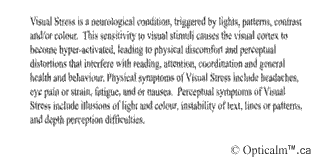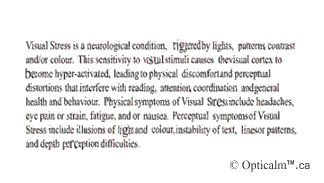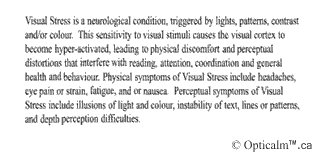Visual Stress: A visual difficulty that affects reading.
What is Visual Stress?
In a Nutshell:
-
Visual difficulties are often associated with dyslexia, but can exist independently. Difficulties that are perceptual in nature and stem from the visual cortex rather than the eye itself are often termed "visual dyslexia," but they are not dyslexia and should not be confused with it. Visual stress is a scientific term for this set of difficulties.
-
Visual Stress when reading is caused by pattern glare which is a combination of black text on a white background and the stripes found in text.
-
It affects around 20% of the population
-
These difficulties cause distortions and discomfort which can make reading difficult and tiring.
-
Using a Coloured Overlay or Reading Ruler of the correct tint has been shown to increase reading speed by over 25%
-
Screening with the Coloured Overlay Assessment pack helps schools to identify which tints may be helpful on an individual basis for children with visual difficulties
-
Writing can also be affected and can be made easier by using coloured exercise books & paper which removes the harsh black and white contrast.
-
Sensitivity and response to coloured filters can change over time, meaning a new colour may help more, or the filter may no longer be needed.
Physical Symptoms of Visual Stress:
- Headaches & Migraines after reading or working on a computer
- Forgetting what you've read
- Getting tired whilst reading.
- Having to re-read text.
- Reading slowly.
Some examples of Visual Symptoms:
In more detail
Visual stress is a relatively common condition of the visual cortex which is often experienced by people with dyslexia, but is now generally accepted to be a separate and distinct condition. Apparent movement and distortion of text, headaches and sore eyes are common symptoms. Coloured Overlays were shown in 2001 to improve reading experience for about 20% of the population; a 2019 study showed that the figure could be higher. A common misnomer is "Scotopic sensitivity," which suggests that it is a condition of the retina and not the visual cortex. Visual difficulties create extra problems for a person with other dyslexic symptoms by making words hard to decipher, but once a Reading Ruler or Overlay has made them visually clearer they still need to be decoded. Dyslexia is commonly defined as a phonological processing deficit, so decoding is an area where dyslexia often causes problems.
Because visual stress is perceptual, rather than optical, in nature, it is not corrected by prescription glasses, and it cannot be detected by standard visual, educational or medical tests.
How do you know if you have Visual Stress?
Symptoms vary , but can include headaches and migraines (especially when working at the computer), eyestrain, and words or letters appearing to "jump" or move on the page. People who have these difficulties see the page differently because of distortions of the print or the white background.
In general, somebody with these visual difficulties may:
- Experience difficulty looking at a computer screen
- Be unusually sensitive to bright lights, especially fluorescent lighting.
- Have difficulty judging heights or distances, which sometimes causes problems with stairs and/or escalators.
- Find driving at night particularly stressful, sometimes experiencing a fragmentation of reflected light.
- Develop headaches and migraines when reading.
- Fatigue quickly when working with text
- Experience problems copying from the board
- Skip words or lines when reading
- Seem to experience increased difficulty after an initial period of about 10 minutes
- Keep moving their head or body position, or moving closer to or further away from the page
- Read slowly and haltingly and have difficulty absorbing information
- Track with the finger
- Yawn while reading.
- Frequently rub their eyes
Visual stress typically causes the following distortions of print, although not all of the following will necessarily be experienced by one person:
- The print appears to jump or otherwise move on the page - sometimes appearing to move off the page altogether.
- Swirling effects appear in the text.
- Whole lines of text may appear to move.
- Shimmering colours may appear on the page.
- White "rivers" may seem to run down the page, where the white background, as opposed to the black text, has become the dominant image perceived.
- Letters may double, reverse, fade or blur. Basically the image of the letters and words is unstable against the white background, and this instability can be experienced in a number of ways.
What can be done?
People with visual stress can read with much greater ease if they cover a print with a specially treated coloured overlay. Screening can help to identify which colour is most beneficial. Crossbow Education supply convenient Reading Rulers and the larger A4 size Coloured Overlays in 16 colours that have been carefully selected to cover the full spectrum in different combinations.
Crossbow also supply the Coloured Overlay Assessment Pack for thorough screening of individual colour preferences. For any optical difficulties, it is important that an optometrist is also consulted to ensure that there are no underlying medical or ophthalmic conditions. Some optometrists prescribe coloured lenses, and specialist equipment to test for colour preference. It is often found that lenses of a different colour from the overlays are needed. A list of specialist optometrists and Irlen centres can be found here.
Does Visual Stress go away?
Generally, no; although there are cases reported where the contrary has been the case. Sensitivity does seem to change though, especially in a changed response to coloured filters. Somebody who has found a particular colour most beneficial may find that this preference changes and a different tint will be more helpful.



